阑尾(或蠕虫状阑尾;也是盲肠[或盲肠]阑尾; vermix;或蠕虫状过程)是一种与盲肠相连的指状盲管,胚胎在胚胎中发育。 盲肠是结肠的袋状结构,位于小肠和大肠的交界处。
“vermiform”一词来自拉丁语,意为“蠕虫状”。
阑尾被称为退化器官,但这种解释可能正在改变。
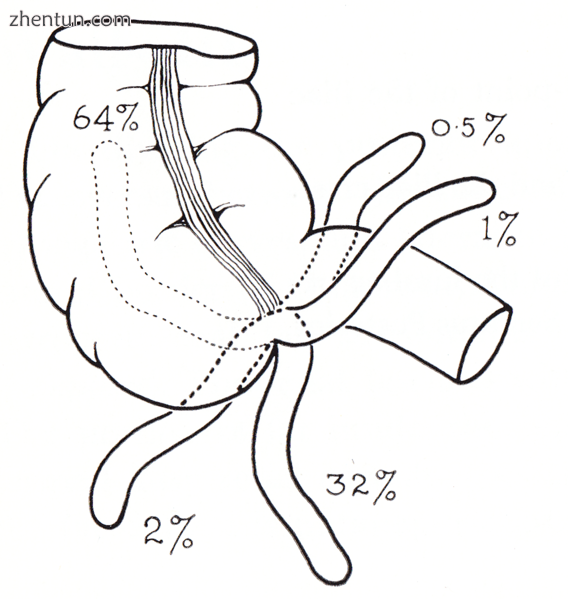
从前面看到的阑尾变异性结肠的绘制
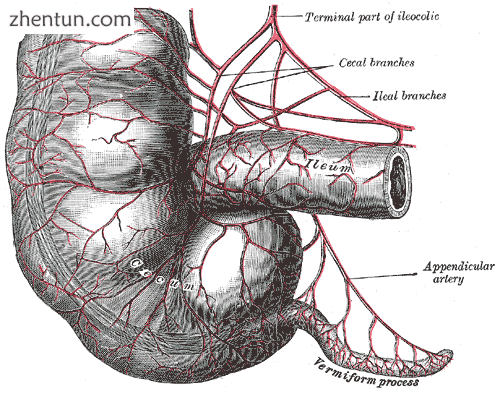
盲肠和阑尾动脉(右下示阑尾蚓状突起)
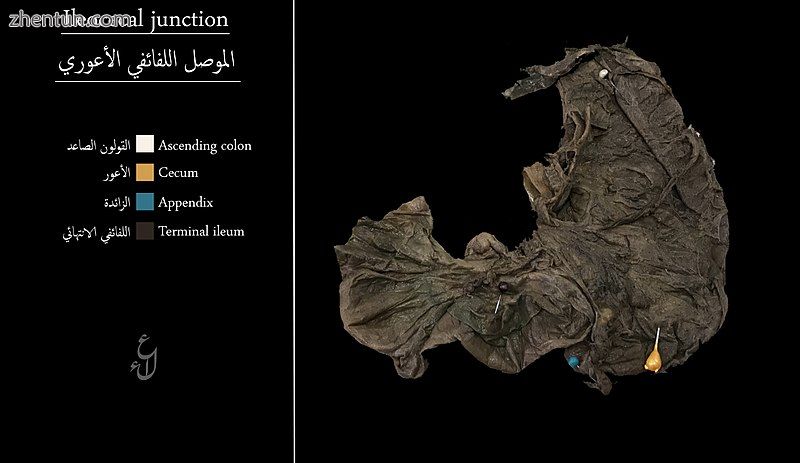
回盲部连接处(阑尾显示为蓝色)
目录
1 结构
1.1 变异
2 功能
2.1 维持肠道菌群
2.2 免疫和淋巴系统
3 临床意义
3.1 阑尾炎
3.2 手术
4 历史
5 其他图像
6 参考
结构
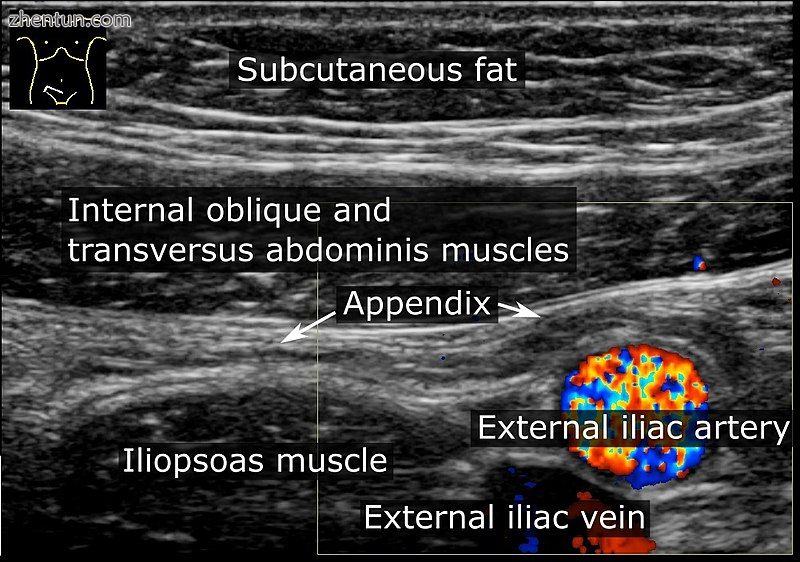
腹部超声显示髂外动脉和腹壁之间的阑尾正常
人类阑尾的平均长度为9厘米,但可以在5到35厘米之间。阑尾直径为6毫米,超过6毫米被认为是增厚或发炎的阑尾。去除的最长的阑尾长26厘米。[1]阑尾通常位于腹部的右下象限,靠近右髋骨。阑尾底部位于回肠瓣下方2厘米处,将大肠与小肠分开。它在腹部内的位置对应于表面上被称为McBurney点的点。
阑尾连接到回肠下部区域的肠系膜,通过称为阑尾系膜的结肠系膜的短区域。[2]
变异
一些相同的双胞胎 - 被称为镜像双胞胎 - 可以具有镜像成像的解剖结构,这是一种先天性疾病,阑尾位于腹部的左下象限。[3] [4]肠旋转不良也可能导致阑尾向左侧移位。
虽然阑尾底部通常位于回盲瓣下方2 cm处,但阑尾尖端可以位于骨盆内,腹膜外或盲肠后方。[5]不同岗位的患病率因人群而异,其中后躯位置在加纳和苏丹最常见,分别为67.3%和58.3%,而伊朗和波斯尼亚的骨盆位置最为常见,分别为55.8%和57.7%分别发生。[6] [7] [8] [9]
在极少数情况下,阑尾可能根本不存在(疑似阑尾炎的剖腹手术频率为10万分之一)。[10]
有时在阑尾的开口处有一个半圆形的粘膜折叠。这种蠕虫状阑尾的瓣膜也称为Gerlach瓣膜。[2]
功能
保持肠道菌群
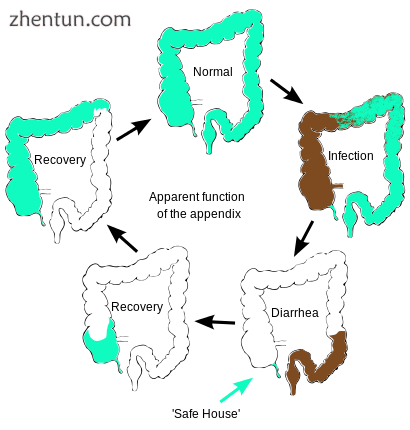
人类阑尾的可能功能是从腹泻中恢复有益细菌的“安全屋”
尽管长期以来人们一直认为阑尾周围的免疫组织和肠道中其他地方的免疫组织(称为肠道相关淋巴组织)具有许多重要功能,但阑尾的独特形状及其明显缺乏特异性缺乏解释。重要性和功能,因其去除后没有副作用来判断。[11]因此,阑尾只是退化的概念变得广泛存在。
杜克大学的William Parker,Randy Bollinger及其同事在2007年提出,当疾病冲刷肠道其他部位的细菌时,阑尾可作为有用细菌的避风港。[12] [13]这个命题是基于21世纪初出现的关于免疫系统如何支持有益肠道细菌生长的理解,[14] [15]结合阑尾的许多众所周知的特征,包括其结构,位置恰好低于大肠中正常的食物和细菌单向流动,以及它与大量免疫组织的关联。在温思罗普大学医院进行的研究表明,没有阑尾的个体复发艰难梭菌结肠炎的可能性是其四倍[16]。因此,阑尾可以作为有益细菌的“安全屋”。[12]然后,这种细菌储存可以在一次痢疾或霍乱之后重新填充消化系统中的肠道菌群,或者在更温和的胃肠道疾病后加以补充。[13]
免疫和淋巴系统
阑尾已被确定为哺乳动物粘膜免疫功能的重要组成部分,特别是B细胞介导的免疫反应和外源性T细胞。这种结构有助于消化系统中废物的正确运动和去除,包含调节病原体的淋巴管,最后甚至可以产生预防致命疾病的早期防御。此外,据认为,这可以为入侵病原体提供更多的免疫防御,并使淋巴系统的B和T细胞与感染肠道部分的病毒和细菌作斗争并对其进行训练,从而使免疫反应成为目标,并且更能够可靠且不太危险地抵抗病原体。[17]此外,还有不同的免疫细胞称为先天性淋巴细胞,它们在肠道中起作用,以帮助阑尾维持消化系统的健康。[18] [19]
临床意义
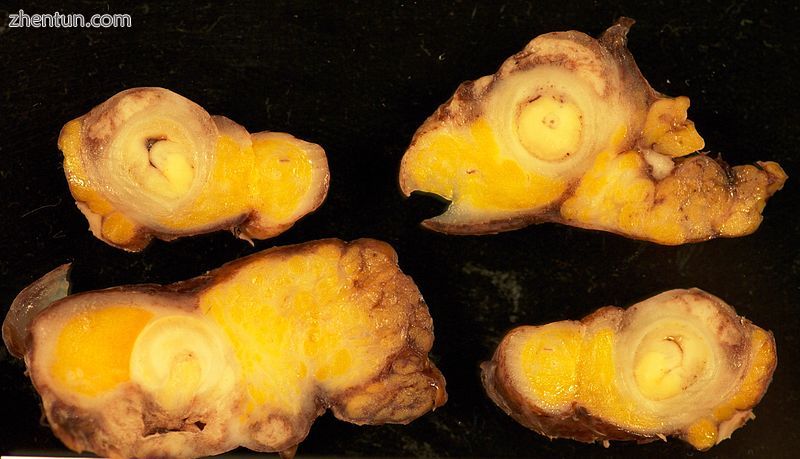
阑尾类癌
阑尾最常见的疾病(人类)是阑尾炎和类癌(阑尾类癌)。[20]所有胃肠道恶性肿瘤中约有1/200阑尾癌症。在极少数情况下,腺瘤也存在。[21]
阑尾炎
主要文章:阑尾炎
阑尾炎是以阑尾炎症为特征的病症。疼痛通常始于腹部中央,对应于阑尾的发育,作为胚胎中肠的一部分。这种疼痛通常是一种暗沉,局部不良,内脏疼痛。[22]
随着炎症的进展,疼痛开始更明确地定位到右下腹,因为腹膜发炎。这种腹膜炎症或腹膜炎导致反弹压痛(除去压力而不是施加压力时的疼痛)。特别是,它呈现在McBurney的位置,沿着从髂前上棘到脐的线的1/3。通常,直到腹膜腹膜发炎,也不会出现点(皮肤)疼痛。发烧和免疫系统反应也是阑尾炎的特征。[22]
阑尾炎通常需要通过剖腹手术或腹腔镜检查在阑尾切除术中切除发炎的阑尾。未经治疗,阑尾可能会破裂,导致腹膜炎,然后休克,如果仍未得到治疗,则会死亡。[22]
手术
主要文章:阑尾切除术
手术切除阑尾称为阑尾切除术。当患者患有急性阑尾炎时,这种移除通常作为紧急程序进行。在没有外科手术设施的情况下,使用静脉内抗生素来延迟或避免败血症的发作。在某些情况下,阑尾炎完全消退;更常见的是,阑尾周围会形成炎症性肿块。这是手术的相对禁忌症。
阑尾还用于建立传出性尿管,在称为Mitrofanoff手术的手术中,[23]用于患有神经源性膀胱的人。
阑尾也被用作进入瘫痪肠道或直肠括约肌主要问题的儿童结肠的手段。将阑尾带到皮肤表面,然后儿童/父母可以连接导管,并使用适当的溶液轻松冲洗结肠(通过正常的排便)。[24]
历史
美国中西部大学的Heather F. Smith博士及其同事解释说:
最近......对肠道免疫力的进一步理解与现有的生物学和医学科学思想相结合,指出哺乳动物盲肠阑尾作为共生肠道微生物的安全屋的明显功能,在社会中胃肠道感染时保存菌群。没有现代医学。该功能可能是阑尾进化和维持的选择性力量。可以在哺乳动物中描述三种形态类型的盲肠阑尾,主要基于盲肠的形状:从圆形或囊状盲肠分枝的独特阑尾(如在许多灵长类动物中),阑尾位于长的顶点和体积庞大的盲肠(如兔子,更大的滑动和沙丘角鼹鼠大鼠),以及没有明显盲肠的阑尾(如袋熊中)。此外,在哺乳动物中发现了狭长的阑尾样结构,这些结构缺乏明显的盲肠(如在单孔中)或在盲肠和阑尾样结构之间缺乏明显的连接(如在考拉中)。盲肠阑尾独立进化至少两次,显然是澳大利亚有袋动物和世界其他地方胎盘形态趋同的又一个例子。虽然阑尾显然已被许多物种所遗失,但至少有一个分支已经保存了超过8千万年。[25]
在最近的一篇论文中,发现阑尾至少发展了32次(可能多达38次)并且失去的次数不超过6次。[26]这表明盲肠阑尾在许多情况下具有选择性优势,并强烈反对其退化性质。阑尾的这种复杂的进化历史,以及它在各种分类群中的进化速率的巨大异质性表明它是一种经常性的特征。[27]
这种功能在缺乏现代卫生和医疗保健实践的文化中可能是有用的,其中腹泻可能是普遍的。 世界卫生组织2001年收集的关于发达国家死亡原因的现有流行病学数据表明,急性腹泻现在是发展中国家与疾病有关的死亡的第四大原因(比尔和梅林达盖茨基金会总结的数据)。 其他两个主要死亡原因预计会产生有限的选择压力或没有选择压力。[28]
其他图片
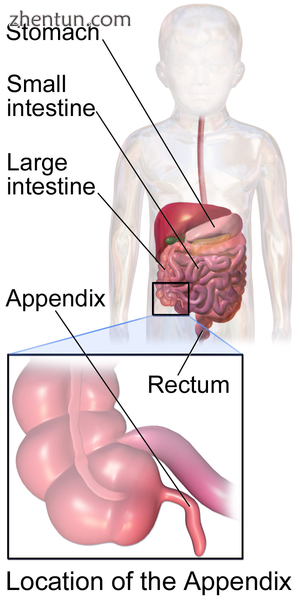
插图描绘了阑尾在儿童中的位置
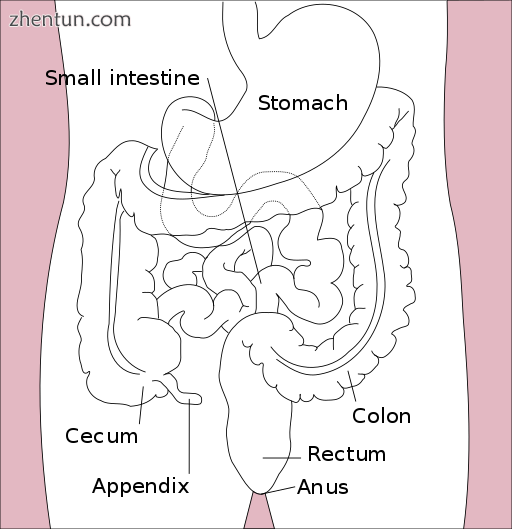
阑尾相对于消化系统其他器官的正常位置(正面图)
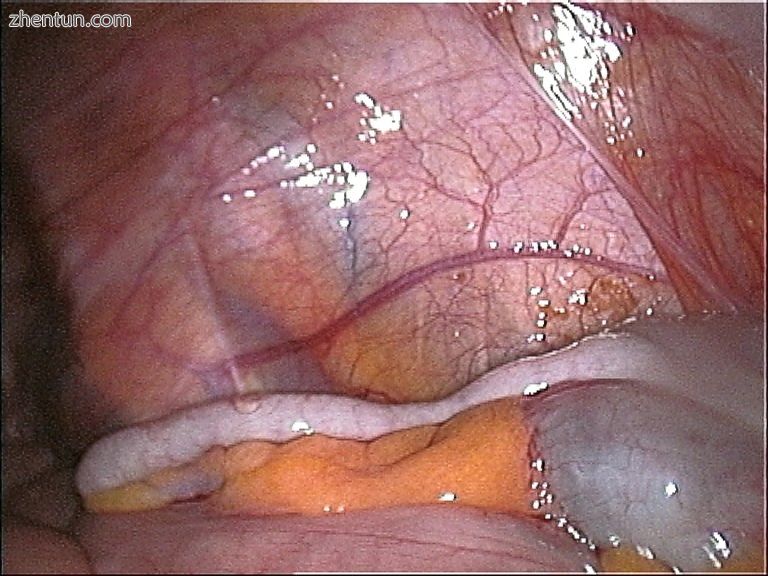
蚓状阑尾
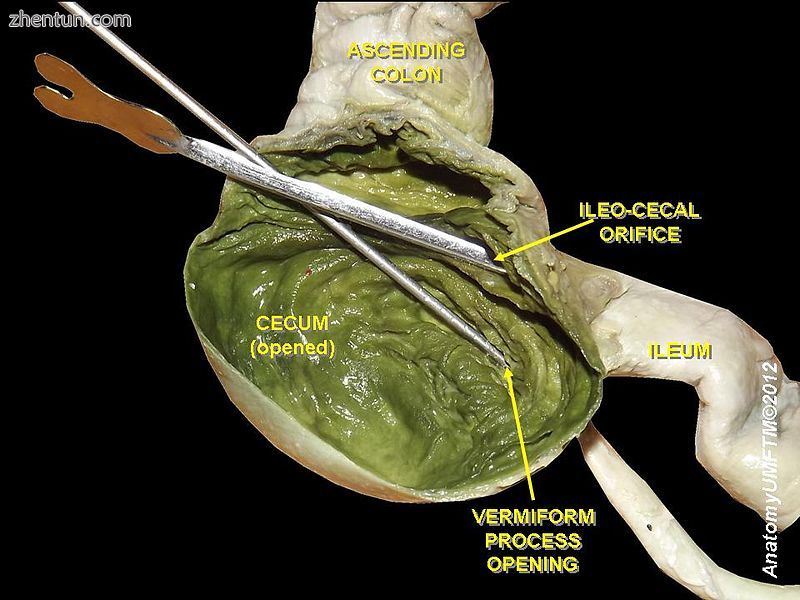
肠盲肠瓣膜及阑尾
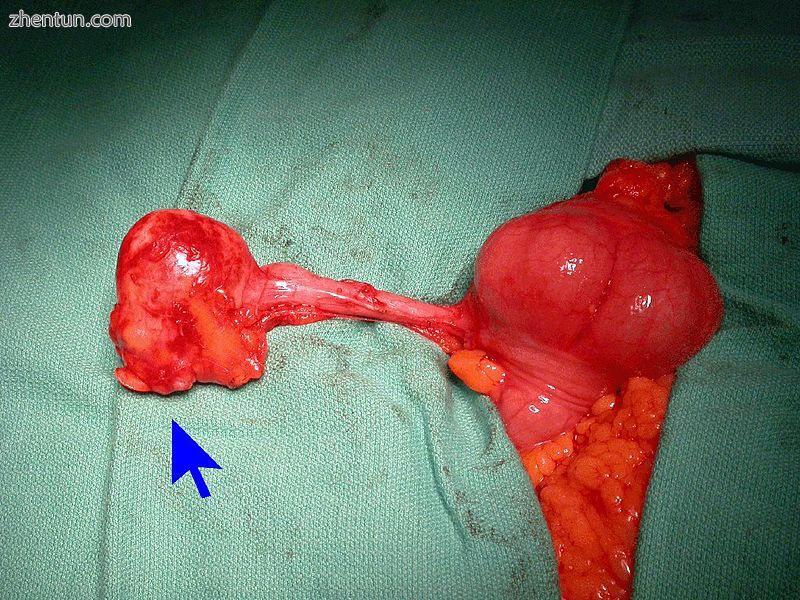
阑尾尖端的粘液腺癌
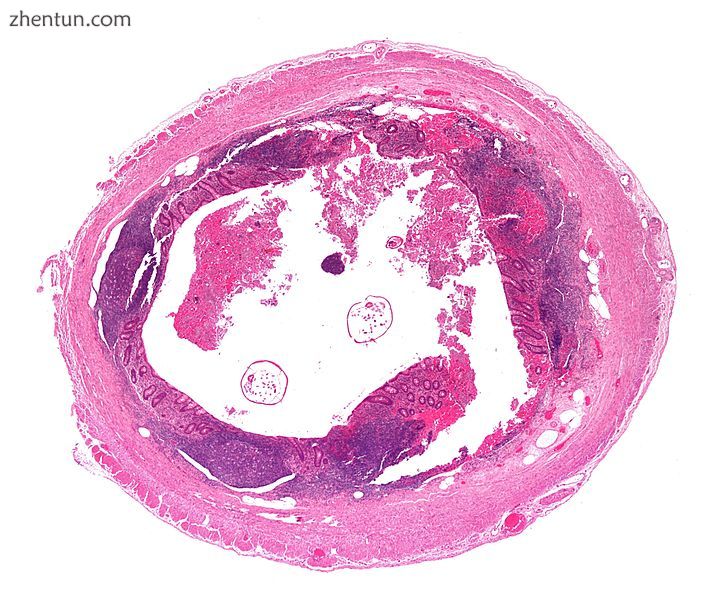
大肠杆菌H&E染色阑尾横截面图
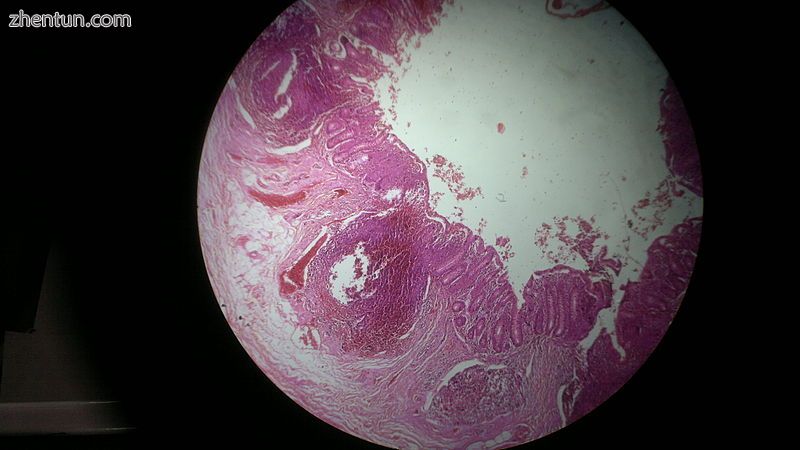
阑尾组织学
另见:
Meckel's diverticulum
参考:
"Largest appendix removed". Guinness World Records. Retrieved 22 May 2017.
Golalipour, M.J.; Arya, B.; Jahanshahi, M.; Azarhoosh, R. (2003). "Anatomical Variations Of Vermiform Appendix In South-East Caspian Sea (Gorgan-IRAN)" (PDF). J. Anat. Soc. India. Retrieved 1 October 2014.[permanent dead link]
"Unusual Types of Twins". Multiples of America. Retrieved 30 April 2014.
Gedda L, Sciacca A, Brenci G, et al. (1984). "Situs viscerum specularis in monozygotic twins". Acta Genet Med Gemellol (Roma). 33 (1): 81–5. doi:10.1017/S0001566000007546. PMID 6540028.
Paterson-Brown, S. (2007). "15. The acute abdomen and intestinal obstruction". In Parks, Rowan W.; Garden, O. James; Carter, David John; Bradbury, Andrew W.; Forsythe, John L. R. (eds.). Principles and practice of surgery (5th ed.). Edinburgh: Churchill Livingstone. ISBN 978-0-443-10157-1.
Clegg-Lamptey JN, Armah H, Naaeder SB, Adu-Aryee NA (2006). "Position and susceptibility to inflammation of vermiform appendix in Accra, Ghana". East Afr Med J. 83 (12): 670–3. PMID 17685212.
Bakheit MA, Warille AA (1999). "Anomalies of the vermiform appendix and prevalence of acute appendicitis in Khartoum". East Afr Med J. 76 (6): 338–40. PMID 10750522.
Ghorbani A, Forouzesh M, Kazemifar AM (2014). "Variation in Anatomical Position of Vermiform Appendix among Iranian Population: An Old Issue Which Has Not Lost Its Importance". Anat Res Int. 2014: 1–4. doi:10.1155/2014/313575. PMC 4176911. PMID 25295193.
Denjalić A, Delić J, Delić-Custendil S, Muminagić S (2009). "[Variations in position and place of formation of appendix vermiformis found in the course of open appendectomy]". Med Arh (in Bosnian). 63 (2): 100–1. PMID 19537667.
Zetina-Mejía CA, Alvarez-Cosío JE, Quillo-Olvera J (2009). "Congenital absence of the cecal appendix. Case report". Cir Cir. 77 (5): 407–10. PMID 19944032.
Kumar, Vinay; Robbins, Stanley L.; Cotran, Ramzi S. (1989). Robbins' pathologic basis of disease (4th ed.). Philadelphia: Saunders. pp. 902–3. ISBN 978-0-7216-2302-3.
Associated Press. "Scientists may have found appendix's purpose". MSNBC, 5 October 2007. Accessed 17 March 2009.
Bollinger, R.R.; Barbas, A.S.; Bush, E.L.; Lin, S.S.; Parker, W. (21 December 2007). "Biofilms in the large bowel suggest an apparent function of the human vermiform appendix". Journal of Theoretical Biology. 249 (4): 826–831. doi:10.1016/j.jtbi.2007.08.032. ISSN 0022-5193. PMID 17936308.
Sonnenburg J.L.; Angenent L.T.; Gordon J.I. (June 2004). "Getting a grip on things: how do communities of bacterial symbionts become established in our intestine?". Nat. Immunol. 5 (6): 569–73. doi:10.1038/ni1079. PMID 15164016.
Everett M.L.; Palestrant D.; Miller S.E.; Bollinger R.R.; Parker W. (2004). "Immune exclusion and immune inclusion: a new model of host-bacterial interactions in the gut". Clinical and Applied Immunology Reviews. 5 (5): 321–32. doi:10.1016/j.cair.2004.03.001.
Dunn, Rob. "Your Appendix Could Save Your Life". Retrieved 22 December 2016.
Zahid, Aliya (2004-04-01). "The vermiform appendix: not a useless organ". Journal of the College of Physicians and Surgeons--Pakistan: JCPSP. 14 (4): 256–258. ISSN 1022-386X. PMID 15228837.
Rankin, Lucille C.; Girard-Madoux, Mathilde J. H.; Seillet, Cyril; Mielke, Lisa A.; Kerdiles, Yann; Fenis, Aurore; Wieduwild, Elisabeth; Putoczki, Tracy; Mondot, Stanislas (2016-02-01). "Complementarity and redundancy of IL-22-producing innate lymphoid cells". Nature Immunology. 17 (2): 179–186. doi:10.1038/ni.3332. ISSN 1529-2908. PMC 4720992. PMID 26595889.
Research, The Walter and Eliza Hall Institute of Medical (2016-08-19). "Lucille Rankin". Walter and Eliza Hall Institute of Medical Research. Retrieved 2016-11-02.
"Appendix disorders Symptoms, Diagnosis, Treatments and Causes". Wrongdiagnosis.com. Retrieved 2010-05-19.
"Statistics about Appendix disorder". Wrongdiagnosis.com. Retrieved 2010-05-19.
Miller R., Kenneth; Levine, Joseph (2002). Biology. Prentice Hall. pp. 92–98. ISBN 978-0-13-050730-3.
Mingin G.C.; Baskin L.S. (2003). "Surgical management of the neurogenic bladder and bowel". Int Braz J Urol. 29 (1): 53–61. doi:10.1590/S1677-55382003000100012. PMID 15745470.
"Wellington Children's Hospital : Caring for an ACE or Chait Tube : Healthpoint". Retrieved 22 December 2016.
Smith H. F.; Fisher R. E.; Everett M. L.; Thomas A. D.; Bollinger, R. R.; Parker W. (2009). "Comparative anatomy and phylogenetic distribution of the mammalian cecal appendix". Journal of Evolutionary Biology. 22 (10): 1984–1999. doi:10.1111/j.1420-9101.2009.01809.x. PMID 19678866.
Smith H. F.; Parker W.; Kotzé, S. H.; Laurin, M. (2013). "Multiple independent appearances of the cecal appendix in mammalian evolution and an investigation of related ecological and anatomical factors". Comptes Rendus Palevol. 12 (6): 339–354. doi:10.1016/j.crpv.2012.12.001.
Laurin M.; Everett, M.L.; Parker W. (2011). "The cecal appendix: one more immune component with a function disturbed by post-industrial culture". Anatomical Record. 294 (4): 567–579. doi:10.1002/ar.21357. PMID 21370495.
Evolution of the Appendix: A Biological 'Remenant' No More; By Duke Medicine News and Communications; Published: 20 August 2009 Updated: 21 August 2009, http://www.dukehealth.org/health ... cal_remnant_no_more |